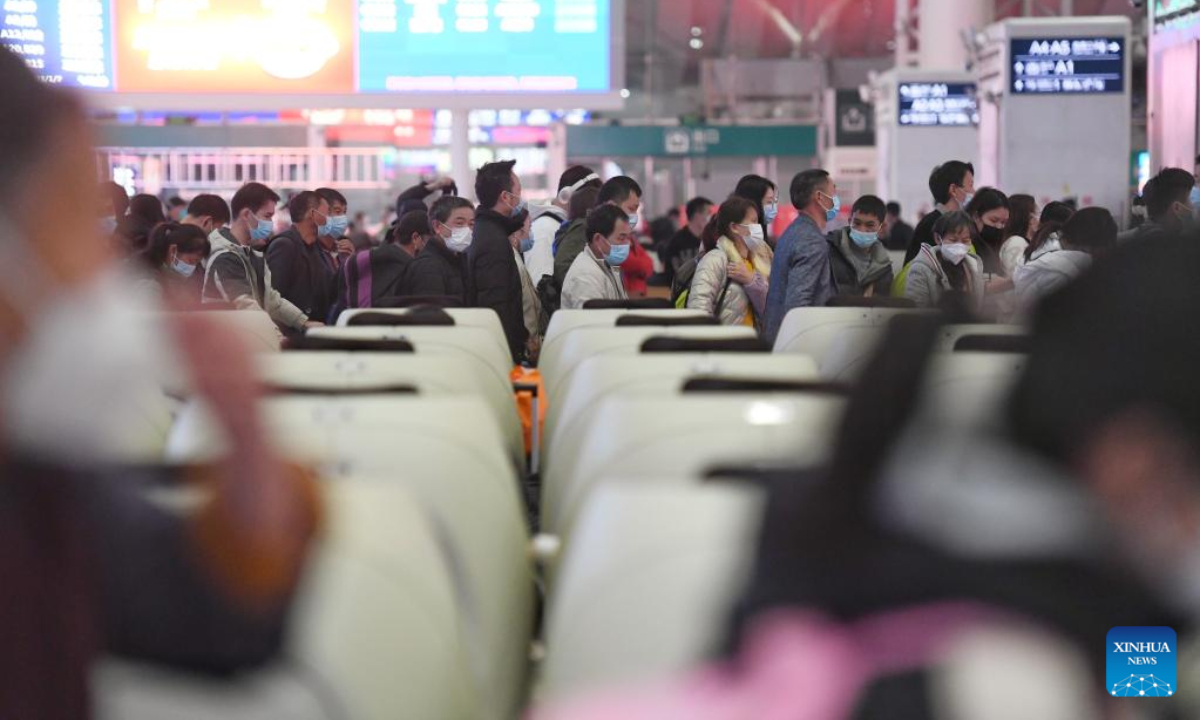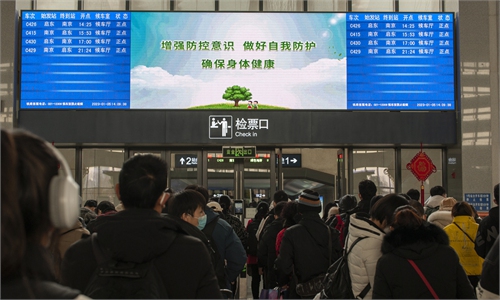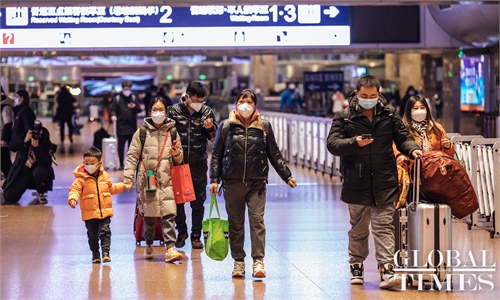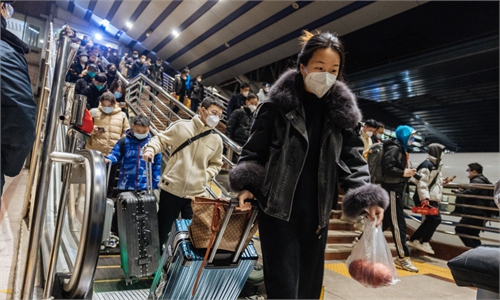Spring Festival travel rush kicks off with a bang
Surging passenger flows accelerate nation's economic revival: expert

Passengers prepare to board a train in Shenzhen North railway station in Shenzhen, south China's Guangdong Province, Jan 7, 2023. Photo:Xinhua
With China's Chunyun or Spring Festival travel rush, the largest annual human migration worldwide, just kicking off, it is expected that travel for this holiday, the first after the nation's policy adjustment on the pandemic, will help bolster local economic activity, which has been dampened by the virus for the past three years.
Although the 2023 Chunyun is marked by many uncertainties as a surge in infections may occur, people's yearning for homeward-bound travel can no longer be restricted, and consumption linked to passenger flows is expected to be a shot in the arm for the world's second largest economy, experts told the Global Times.
A total of 34.736 million passenger trips were made by railways, highways, waterways, and civil aviation across the country on Saturday, up 38.9 percent over the same period in 2022, the official data showed on Sunday.
National railways are estimated to have carried 6.3 million passengers, according to China Railway. More than 10,000 domestic flights were scheduled on Saturday, a year-on-year increase of 13 percent, and the daily passenger volume exceeded 1 million, reaching a peak unseen in months, according to data from Umetrip, a popular flight information app in China.
The number of passenger trips during this year's Spring Festival travel season is expected to surge 99.5 percent from the same period last year to reach nearly 2.1 billion. Passenger trips by air, rail and road are set to reach 70.3 percent of the pre-pandemic levels in 2019, Xu Chengguang, an official from the Ministry of Transport, told a press conference on Friday.
"It is still very good to estimate passenger traffic reaching 70 percent of the level of 2019, because the average passenger traffic in China in the past three years might not have reached half of that in 2019," Tian Yun, a veteran economist and former vice director of the Beijing Economic Operation Association, told the Global Times on Sunday.
In its latest move, China downgraded the management of COVID-19 from Class A to Class B starting from Sunday. In early December, the country adjusted its virus prevention and control policies with 10 new measures, shifting the policy focus from infection prevention to prevention of severe cases.
Xu said the 2023 Chunyun will have the most uncertainties, and could be the most complex in recent years.
Although many places in China are still experiencing peak outbreaks, and some people are still fighting the virus, "we have seen people's yearning to return to the pre-pandemic state under the current adjustment of COVID prevention and control policies is very strong," Tian said.
"With the optimization and adjustment of COVID prevention and control measures and the accelerated cross-regional personnel flows, the passenger flows during the Spring Festival travel season will shift from low-level operation to rapid recovery," he added.
In the past two years, the majority of Chinese people stayed put amid virus curbs during the festival. They are now swarming into train stations, airports and long-distance bus terminals to travel for family reunions on the Lunar New Year's eve, which falls on January 21 this year.
Data from online travel agency Trip.com showed that since January 4, the popularity of Spring Festival travel among passengers on the platform has soared, and the number of railway travel inquiries and reservations recorded new highs for three consecutive days.
The person in charge of relevant business at the company said that due to the optimistic travel expectations of passengers and their urgent desire to return home, the travel booking peak in 2023 is about one week earlier than previous years under the impact of the COVID-19 control measures, and booking popularity will continue to grow.
Notably, this year's Spring Festival travel rush will see the passenger travel radius reach the highest level in three years.
Compared with the average travel radius of 402 kilometers for railway travel and 1,369 kilometers for flights last year, as of 9 am on Saturday, the travel radius of railway for the 2023 Spring Festival travel rush reached 692 kilometers, up 72 percent and that of the air travel orders reached 1,950 kilometers, up 43 percent.
"Thanks to the free flow of people, we can see the revival of economic activities: accommodation, catering and sales at scenic spots... where there are visitors, there is hope of economic revival," Tian said.
More domestic consumption will further drive investments and expand government revenues, which are used to improve local infrastructure and social welfare to better facilitate consumption, forging an upward economic cycle, he said.
Tian said that the summer holidays in 2023 will likely see passenger flows reaching the same levels of 2019, and the week-long National Day holidays in early October may witness another travel peak, putting the pandemic further away in the rear mirror.



